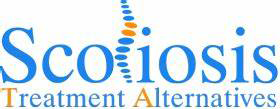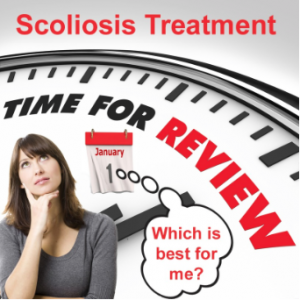 Introduction
Introduction
Most people who come to this site are browsing the Internet looking for the most up-to-date scoliosis treatment information on the internet. While there is a seemingly endless amount of information available, if you have spent any amount of time doing this you have probably found that there is conflicting information on many sites.
Unfortunately, there is little policing when it comes to the content found on internet sites, which makes it easy for anyone to make unsubstantiated treatment claims. To help decide which advice on scoliosis treatment is sound and which is unproven when reading such advice ask yourself the 10 questions:
Top 10 Questions to Ask About Scoliosis Treatment
1. What are the credentials of the person(s) offering advice?
Determine if the person offering advice has credentials in musculoskeletal treatment from an accredited college or university. Their credentials should be listed somewhere on the website and they should be related to the type of treatment that they offer.
For instance, while an orthopedic surgeon is certainly the best specialist to discuss which type of scoliosis surgery you may need, they may have very little, if any, experience with non-surgical scoliosis treatment so their advice on this topic should be taken with a grain of salt.
The best source for the most up-to-date and accurate conservative scoliosis treatment information is an organization called Society on Scoliosis Orthopaedic Rehabilitation and Treatment (SOSORT). Each year this international society of doctors, therapists and other health care professionals who specialize in the non-surgical treatment of scoliosis meet to discuss the latest research on scoliosis treatment. This is a good place to start to gain an appreciation of what types of scoliosis treatment are scientifically sound.
If you are seeking a provider of non-surgical scoliosis treatments that are in keeping with the SOSORT guidelines you should seek a provider, (physical therapist, chiropractor, physical medicine specialist, osteopath or movement therapist), that specializes in the management of scoliosis, rather than someone who does it occasionally.
In addition to their normal credentials of an advanced degree in their particular specialty they should also be certified in other post-graduate training courses related to the management of scoliosis and they should also participate regularly in continuing-education programs, like SOSORT conferences.
2. What is the site’s purpose and objective?
The purpose and objective of the site should be clearly stated on the site itself. For instance, Scoliosis Treatment Alternative’s purpose is to provide information and resources about comprehensive non-surgical scoliosis treatment. By clearly stating the objective you can determine if the site is there to educate, promote a product or service or both.
3. What are their scoliosis claims, and do they have scientific evidence to back their claims?
Many sites make claims based on a case or two or the doctor’s experience treating scoliosis patients, but don’t count on just that case or someone’s professional experience alone. Ask the question: Are their scoliosis treatment claims based on sound evidenced based research that is published in a peer-reviewed journal, such as Spine, STA Treatment Reviews or the SOSORT Scoliosis Journal? Make sure enough research has been done in the area that you are specifically seeking treatment.

4. Do they have many video testimonials of scoliosis patients with cases similar to yours to watch?
While patient testimonials by themselves should not be relied upon to determine if the treatment will work for you, they can be helpful in determining if the provider has experience in successfully treating cases similar to yours.
5. Do they promise a quick fix?
Beware of sites that offer a quick fix for your scoliosis. While there are certain types of scoliosis, (ie: functional scoliosis) that can get a quick resolution when the right therapy is applied, in most cases there is no magic bullet for the treatment of scoliosis. While mobilizing the spine in the correct way can yield very impressive reductions in the curves, it is almost always short lived unless the nervous system can be trained to hold those corrections. If no form of stabilization therapy is put into place then chances are the scoliosis spine will go right back to it’s previous shape because the forces that were driving the scoliosis have not been adequately addressed.
Depending on your age, degree of curve, amount of degenerative changes in the spine your scoliosis treatment program goals will vary. For an adult the therapeutic goal may be pain relief and stopping further progression of the curvature, while an adolescent that is just hitting puberty correction a permanent correction of the scoliosis curve may be a reasonable therapeutic goal. The goals for your care should be based entirely on your curve pattern and the particulars of your case of scoliosis, not what was achieved with someone else.
Almost all scoliosis management programs require time to take effect, especially when long term correction is your goal. A solid scoliosis treatment program should provide you with tools and guidelines to follow to manage your scoliosis for life. If the only thing that is being offered is a “quick fix” with no corrective movement therapy or follow-ups then you should be cautious. A good scoliosis care program offers continual support and instruction on behavioral changes that you can use for the long-term management of your scoliosis.
6. Are Corrective Movement Therapies being omitted from the scoliosis treatment plan?
 Whether incorporating the use of a scoliosis brace, experts agree that a sound comprehensive scoliosis program includes some form of specific corrective movement therapy such as Schroth or SEAS. A retrospective study presented at the 2009 SOSORT conference in Lyon found that a comprehensive program of conservative scoliosis care that included corrective movement exercises for scoliosis with bracing gave the best results overall. It showed that programs that had a high degree of therapist involvement and combined the use of scoliosis specific exercises with bracing had a high level of treatment compliance and 96% of the scoliosis patient’s curvatures did not progress and many had a statistically significant reduction in their Cobb angles, ATR and aesthetics.
Whether incorporating the use of a scoliosis brace, experts agree that a sound comprehensive scoliosis program includes some form of specific corrective movement therapy such as Schroth or SEAS. A retrospective study presented at the 2009 SOSORT conference in Lyon found that a comprehensive program of conservative scoliosis care that included corrective movement exercises for scoliosis with bracing gave the best results overall. It showed that programs that had a high degree of therapist involvement and combined the use of scoliosis specific exercises with bracing had a high level of treatment compliance and 96% of the scoliosis patient’s curvatures did not progress and many had a statistically significant reduction in their Cobb angles, ATR and aesthetics.
While programs that do not use these types of care can have some benefit in some cases, the majority of time a multimodality approach is best when it comes to scoliosis treatment. Eliminating corrective movement therapy from a scoliosis care program is generally not recommended unless it is contraindicated because of severe scoliosis related pain. If so, initiation of the program should be delayed until the pain has been reduced.
Patients should be weary of programs that recommends simply wearing a hard brace, without other types of care, as hard bracing causes immobilization and can actually result in worsening of the curvatures once the brace is removed. This is due to the resultant stiffness, rigidity and muscle atrophy caused by the immobilization of the torso by the hard brace. In the case of hard bracing, exercises are often used to offset the negative effects of hard bracing.
This is one of the reasons why we recommend dynamic bracing with the SpineCor brace rather than hard bracing as it does not have the side effects associated with atrophy as the patient is able to move in the SpineCor brace. In fact, SpineCor is the only type of scoliosis brace that clinically offers the potential for correction of the curvatures.
8. Does the site recommend special tests to determine the risk of your scoliosis progression or the ability to monitor your curves without the use of x-rays?
While simple at home scoliosis screening can be taught to parents to monitor a scoliosis in the early stages there are better ways to monitor scoliosis progression. The most common method is to x-ray the patients spine every 4-6 months during growth. The problem with this is that it exposes the child to a tremendous amount of radiation over the course of their care.
 A better tool for monitoring is a non x-ray technology known as Rastersterography (aka Formetric). This type of imagining evaluates the topography of patients back to determine if the curve is progressing or not. It is a far more sensitive tool for measuring rotation of the spine than the gold standard measurement of a Cobb angle on x-ray and of equal importance, it does this without any radiation exposure to the patient.
A better tool for monitoring is a non x-ray technology known as Rastersterography (aka Formetric). This type of imagining evaluates the topography of patients back to determine if the curve is progressing or not. It is a far more sensitive tool for measuring rotation of the spine than the gold standard measurement of a Cobb angle on x-ray and of equal importance, it does this without any radiation exposure to the patient.
Scoliscore is a genetic saliva test that examines your risk of scoliosis progression. It can be used to help determine which types of conservative treatment may be best for you based on your Scoliscore, a higher score means a greater risk of progression.
9. Is the URL and focus of the website specific for scoliosis?
Is the site specifically dedicated to the conservative treatment of scoliosis or is it just a sideline for the practitioner who does a variety of things or has a general type of practice. Since scoliosis is a multidimensional problem it is best to seek out treatment with someone who focuses on the scoliosis care.
10. Is the site updated with new posts regularly?
A reliable website should be updated regularly to keep up with the most current scoliosis information and treatment research available, but keep in mind that being current information doesn’t necessarily make it accurate but at least you know the practitioner is keeping up with what is on the cutting edge of scoliosis treatment.
Summary
The Internet contains a wealth of information, which often makes it difficult for the lay person to determine is accurate. For this reason, there is no substitute for a licensed practitioner who is well versed in scoliosis to determine your exact treatment needs and what your reasonable goals should be.
By asking questions like these you can find an appropriate doctor in your area for treatment and avoid a disaster caused by following mis-information that is frequently found on the Internet. The rule of thumb should be that if it sounds too good to be true, it most likely is.

The answers to the Top 10 Questions to Ask About Scoliosis Treatment information is provided by Scoliosis Treatment Alternatives for your consideration and is not intended to replace the medical advice provided by a doctor or other health care provider. Please consult your health care provider if they are knowledgeable on non-surgical treatment of scoliosis. If they are not then search for a provider based on the above information to seek advice about your specific case of scoliosis.

